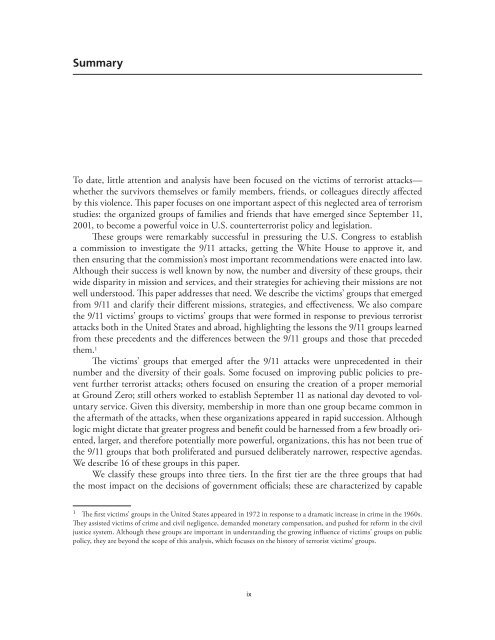The Victims of Terrorism: An Assessment of Their Influence and ...
The Victims of Terrorism: An Assessment of Their Influence and ...
The Victims of Terrorism: An Assessment of Their Influence and ...
You also want an ePaper? Increase the reach of your titles
YUMPU automatically turns print PDFs into web optimized ePapers that Google loves.
SummaryTo date, little attention <strong>and</strong> analysis have been focused on the victims <strong>of</strong> terrorist attacks—whether the survivors themselves or family members, friends, or colleagues directly affectedby this violence. This paper focuses on one important aspect <strong>of</strong> this neglected area <strong>of</strong> terrorismstudies: the organized groups <strong>of</strong> families <strong>and</strong> friends that have emerged since September 11,2001, to become a powerful voice in U.S. counterterrorist policy <strong>and</strong> legislation.<strong>The</strong>se groups were remarkably successful in pressuring the U.S. Congress to establisha commission to investigate the 9/11 attacks, getting the White House to approve it, <strong>and</strong>then ensuring that the commission’s most important recommendations were enacted into law.Although their success is well known by now, the number <strong>and</strong> diversity <strong>of</strong> these groups, theirwide disparity in mission <strong>and</strong> services, <strong>and</strong> their strategies for achieving their missions are notwell understood. This paper addresses that need. We describe the victims’ groups that emergedfrom 9/11 <strong>and</strong> clarify their different missions, strategies, <strong>and</strong> effectiveness. We also comparethe 9/11 victims’ groups to victims’ groups that were formed in response to previous terroristattacks both in the United States <strong>and</strong> abroad, highlighting the lessons the 9/11 groups learnedfrom these precedents <strong>and</strong> the differences between the 9/11 groups <strong>and</strong> those that precededthem. 1 <strong>The</strong> victims’ groups that emerged after the 9/11 attacks were unprecedented in theirnumber <strong>and</strong> the diversity <strong>of</strong> their goals. Some focused on improving public policies to preventfurther terrorist attacks; others focused on ensuring the creation <strong>of</strong> a proper memorialat Ground Zero; still others worked to establish September 11 as national day devoted to voluntaryservice. Given this diversity, membership in more than one group became common inthe aftermath <strong>of</strong> the attacks, when these organizations appeared in rapid succession. Althoughlogic might dictate that greater progress <strong>and</strong> benefit could be harnessed from a few broadly oriented,larger, <strong>and</strong> therefore potentially more powerful, organizations, this has not been true <strong>of</strong>the 9/11 groups that both proliferated <strong>and</strong> pursued deliberately narrower, respective agendas.We describe 16 <strong>of</strong> these groups in this paper.We classify these groups into three tiers. In the first tier are the three groups that hadthe most impact on the decisions <strong>of</strong> government <strong>of</strong>ficials; these are characterized by capable1 <strong>The</strong> first victims’ groups in the United States appeared in 1972 in response to a dramatic increase in crime in the 1960s.<strong>The</strong>y assisted victims <strong>of</strong> crime <strong>and</strong> civil negligence, dem<strong>and</strong>ed monetary compensation, <strong>and</strong> pushed for reform in the civiljustice system. Although these groups are important in underst<strong>and</strong>ing the growing influence <strong>of</strong> victims’ groups on publicpolicy, they are beyond the scope <strong>of</strong> this analysis, which focuses on the history <strong>of</strong> terrorist victims’ groups.ix
















